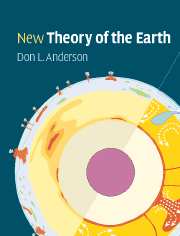Book contents
- Frontmatter
- Contents
- Preface and Philosophy
- Abbreviations and acronyms
- Part I Planetary perspective
- Part II Earth: the dynamic planet
- Part III Radial and lateral structure
- Part IV Sampling the Earth
- Part V Mineral physics
- Chapter 18 Elasticity and solid-state geophysics
- Chapter 19 Dissipation
- Chapter 20 Fabric of the mantle
- Chapter 21 Nonelastic and transport properties
- Chapter 22 Squeezing: phase changes and mantle mineralogy
- Part VI Origin and evolution of the layers and blobs
- Part VII Energetics
- References and notes
- Appendix
- Index
Chapter 19 - Dissipation
Published online by Cambridge University Press: 05 June 2012
- Frontmatter
- Contents
- Preface and Philosophy
- Abbreviations and acronyms
- Part I Planetary perspective
- Part II Earth: the dynamic planet
- Part III Radial and lateral structure
- Part IV Sampling the Earth
- Part V Mineral physics
- Chapter 18 Elasticity and solid-state geophysics
- Chapter 19 Dissipation
- Chapter 20 Fabric of the mantle
- Chapter 21 Nonelastic and transport properties
- Chapter 22 Squeezing: phase changes and mantle mineralogy
- Part VI Origin and evolution of the layers and blobs
- Part VII Energetics
- References and notes
- Appendix
- Index
Summary
As when the massy substance of the Earth quivers.
MarloweReal materials are not perfectly elastic. Solids creep when a high stress is applied, and the strain is a function of time. These phenomena are manifestations of anelasticity. The attenuation of seismic waves with distance and of normal modes with time are other examples of anelastic behavior. Generally, the response of a solid to a stress can be split into an elastic or instantaneous part and an anelastic or time-dependent part. The anelastic part contains information about temperature, stress and the defect nature of the solid. In principle, the attenuation of seismic waves can tell us about such things as small-scale heterogeneity, melt content, dislocation density and defect mobility. These, in turn, are controlled by temperature, pressure, stress, history and the nature of the defects. If these parameters can be estimated from seismology, they can be used to estimate other anelastic properties such as viscosity.
For example, the dislocation density of a crystalline solid is a function of the non-hydrostatic stress. These dislocations respond to an applied oscillatory stress, such as a seismic wave, but they are out of phase because of the finite diffusion time of the atoms around the dislocation. The dependence of attenuation on frequency can yield information about the dislocations. The longer-term motions of these same dislocations in response to a higher tectonic stress gives rise to a solid-state viscosity.
- Type
- Chapter
- Information
- New Theory of the Earth , pp. 246 - 255Publisher: Cambridge University PressPrint publication year: 2007



